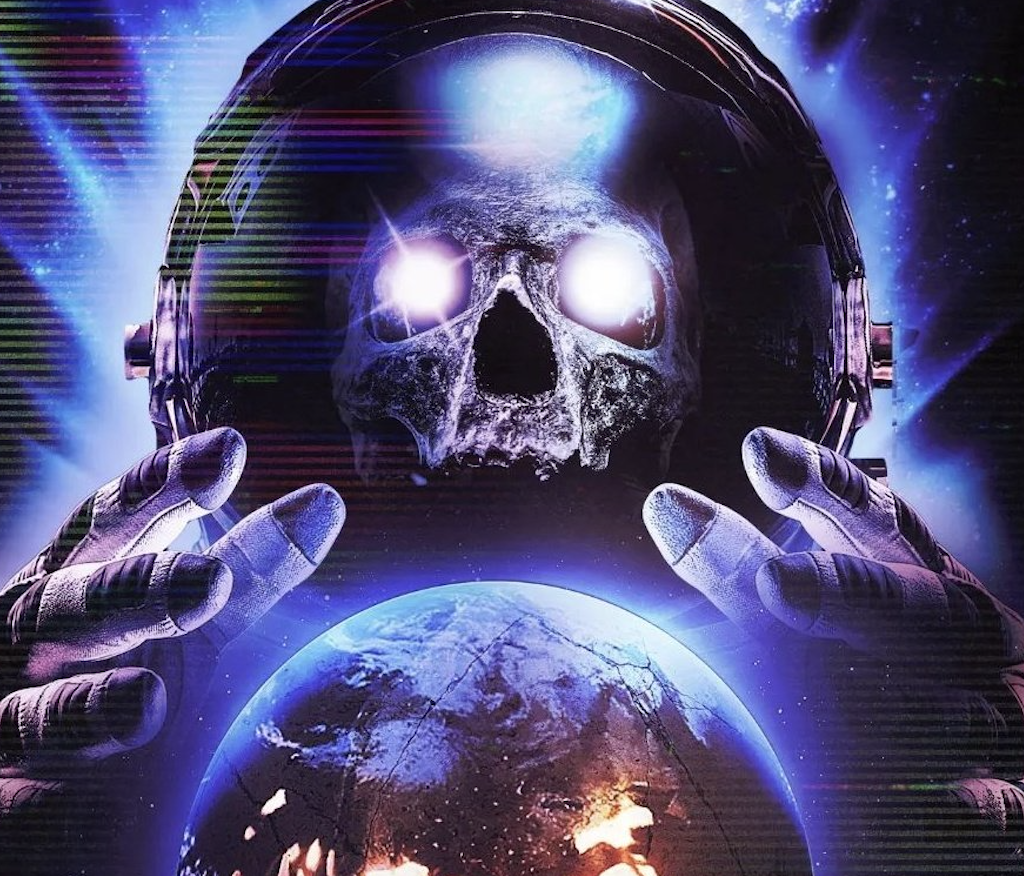V/H/S BEYOND is . . . hard to describe.
It is a →
- found footage / forced perspective,
- science-fiction,
- horror,
- anthology
→ film
It is the seventh installment in the series (but ninth overall) in the V/H/S franchise.
The film takes up a feature film block of time, but operates more like a shorts program, but better. In the film, there are five different short stories that are all woven together by one overarching mockumentary that discusses a specific found footage video.
In the format of the film, the audience is first introduced to the fictional documentary, then a short is played, back to the documentary, back to a short – until finally they play through the clip that the documentary is about before ending.
Personally, I love anthologies because of how perfectly bite-sized the stories are. They’re kind of like sampler plates at restaurants. You get a little bit of everything without getting too full on any one thing.
What surprised, impressed, and inspired me the most about V/H/S BEYOND is how the film uses the anthology structure and style to effectively deliver an effective and creative horror experience.
In this article, I will be discussing how horror as a genre works by playing a game with your internal defense mechanisms and how V/H/S BEYOND utilizes this dynamic to deliver an exceptional horror experience.
Horror as a Genre
This might be a hot take.
I wholeheartedly believe that regardless of experience and receptivity, horror is the single most honest genre of film.
What I mean by this is, when you opt in for an experience of a horror film, you know exactly what game you’re playing.
The material has one singular objective.
It is going to try to scare you.
And in response, you have one singular objection.
You will try to not be scared.
Based on this, a “good” horror is one that successfully plays this game and fulfills its primary objective.
Good horror SCARES audiences.
In other genres – drama, action, romance, etc – there’s more subjective flex and play. These types of stories aim to convey and communicate a subjective idea or theme and that is their primary purpose.
- With drama – it’s about building and releasing tension.
- With action – it’s about creating excitement.
- With romance – it’s about expressing an opinion of love.
They each have their own games, but all these other genres hit their mark with a wider variety of methods with varying degrees of success from person to person.
Horror is also specific in its effect from person to person, but the game is more straightforward than those other genres.
A close second place in terms of “honesty” is comedy, which is arguably the inverse of horror. Horror and comedy often have a similar set up, the only notable differences are the punchlines and the soundtrack.
For most instances of comedy, the display is funny because there’s a layer of separation and we observe seemingly terrible things happen to people that aren’t us from a safe distance.
That said, if we were the ones experiencing those moments, it would be embarrassing at best and terrifying at worst. Think of how you would feel if you were actually in an Adam Sandler movie and ridiculous things that defy the conventional laws of logic and nature were happening to you.
On that same thread of the relationship between horror and comedy, that’s how people like Jordan Peele can do both. He has the wildly successful sketch comedy show, KEY AND PEELE, but he also has his selection of horror films. Which, in terms of where he ranks in both domains, I feel his horror in the context of horror is better than his comedy in the context of comedy. Maybe because horror is more objective and his talent is more focused in that realm.
That’s beside the point though.
A Game of Defense Mechanisms
Back to horror.
Horror is honest because while there may be different types of horror – those are all different moves and methods that still have the same objective. They exist to scare you.
But what is that feeling that they’re trying to give?
It is fear.
Fear is a primal feeling baked into our existence as living creatures that is directly related to our natural instinct and desire to survive.
If we psychologically recognize a threat, whether or not we understand that threat (what it is, how it works, why it’s scary), our natural response is fear.
Fear as a feeling manifests itself into an action which is the conventional – fight, flight, or freeze.
The thing about horror films (specifically ones you watch in a movie theater), you are restricted from two out of those three options.
You can’t fight the images on the screen.
Technically, you can walk out the theater to end the experience, but you can’t necessarily flee from something that isn’t directly and physically in front of you.
Based on this, you have no choice but to freeze.
You have to sit and witness what’s going on.
From here, the response is also natural and somewhat unconscious.
In response to the presentation of distressing material, we try to understand what’s going on. It’s almost like a form of bargaining. The next time you’re watching a truly scary movie, pay attention to the room. When something bad happens, there’s always going to be one or two people that try to make a joke in order to alleviate the tension they’re feeling.
Whatever the course of action, this is just a defense mechanism that happens on a subconscious level.
While most people opt into horror films wanting to be scared, they have little control over their mind and its intrinsic processes. When something is scary, we instinctively try to make sense out of it, to reduce the psychological and emotional damage. And because we mentally digest that material, after experiencing it once, it is never as scary on the second time around.
You can see this with films that rely on jump scares.
The first time you watch a film with a good jump scare, the moment might cause some popcorn to fly.
However, the second time you watch that scene, because you know what’s coming, whether you want to or not, you reflexively brace yourself for that scene.
The same trick doesn’t work twice.
The defense mechanism in response to the horror has been established.
The Experience of V/H/S Beyond
From the moment you first experience that monster – every time it’s on the screen, even though the events and contexts are different, you fear that monster a little less than the last time you saw it.
The first time it appears, there’s this jolt of awareness caused by how unnatural it is.
The tenth time it appears, you might still see it as a threat based on the context of the story and the monster’s intrinsic malevolence, but it’s more of a recognizable “character.”
And if you take this concept to the highest level, by the hundredth or even thousandth time you see the monster, it’s less of a character and more of a costume.
Note: In order for a monster to be around in the “thousands” category it is usually when the horror film it originates from becomes so insanely successful that it spawns vast amounts of Halloween merch fodder. Which, because of mass wide adoption, quickly evolves into a meme. That’s how you have TikToks of horror icons doing silly dances. The concept of that monster is so stale in the cultural zeitgeist that they become a joke. Again – this is the tail end effect of the defense mechanism becoming too strong.
What makes V/H/S BEYOND so special and so good at the game that is horror is that it understands and recognizes how the game of horror and defense mechanisms work and then uses that understanding of the game to the audience’s disadvantage.
V/H/S BEYOND is an anthology.
It is a compilation of five (technically six) different short stories that each have their own sets of rules and logic.
After witnessing the first short story, you build these natural defense mechanisms that are specific for that story world.
But then you enter the second story which operates on a completely different ruleset. You look for one type of monster based on your previous experience, but because this is a new world, that monster does not look the same.
And then this happens for the third story.
And the fourth story.
And the fifth.
With every new sequence, you’re constantly shaken up and thrown off your foundation. And because your only primary defense is a completely unconscious defense mechanism, you are constantly reaching for something that simply isn’t there.
It’s chaotic, slightly out of control, and incredibly effective at delivering horror.

Myka Arakawa is a creative rogue born and raised in Hawai’i, with a passion for storytelling and the creative process. He holds a deep curiosity for the true nature of creative expression and has explored modes such as fiction, nonfiction, poetry, screenwriting, guitar, music production, graphic design, web design, cooking, and jiu jitsu. Myka believes in the power of creative work as a positive sum solution that can change the world, for the better for forever, and for everyone. His mission is to capture, preserve, and further the culture of his home.
The HIFF ONLINE CREATIVES & CRITICS IMMERSIVE (HOCCI) program supports sustainable film criticism in Hawai’i through mentorship and paid career opportunities for Hawai’i-based AANHPI critics. The mission of HOCCI is to broaden diversity in film criticism across the Pacific and use influencer branding strategies to spark career opportunities. The 2024 HOCCI is supported by Critical Minded, a grant-making and learning initiative that supports cultural critics of color in the United States.



